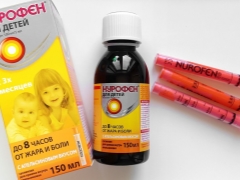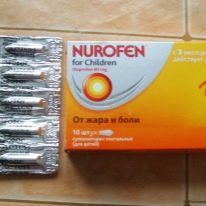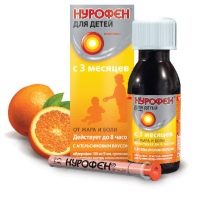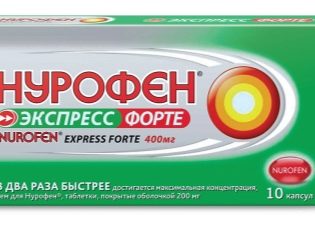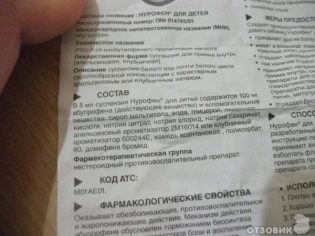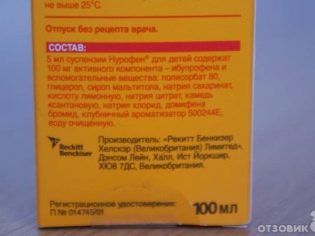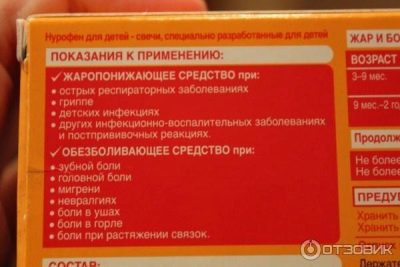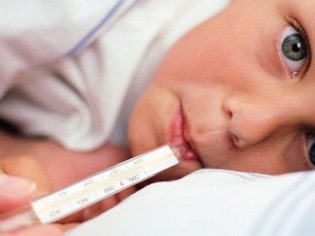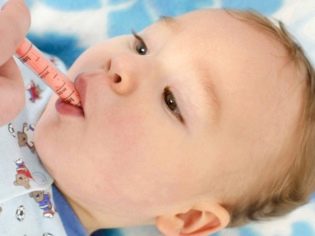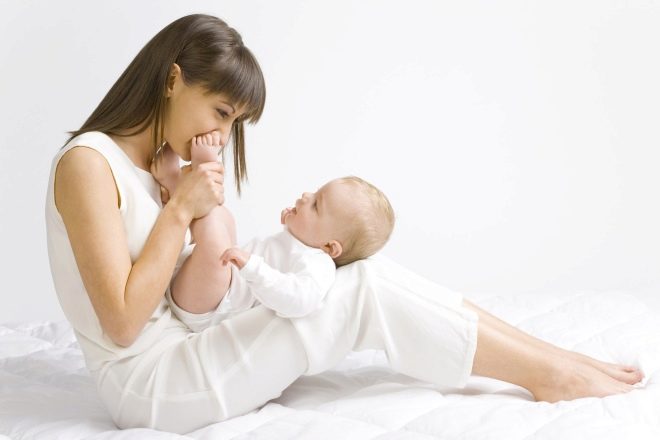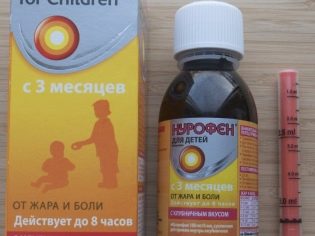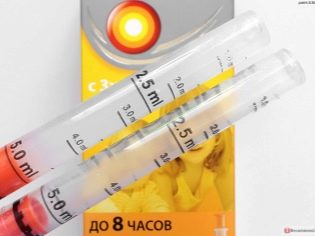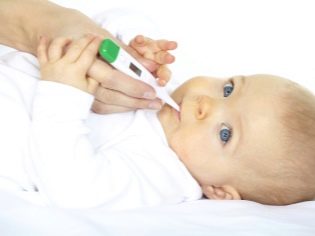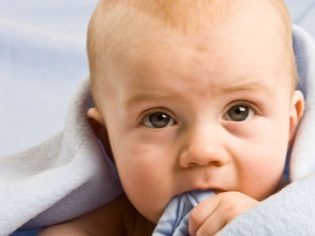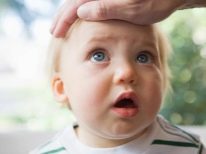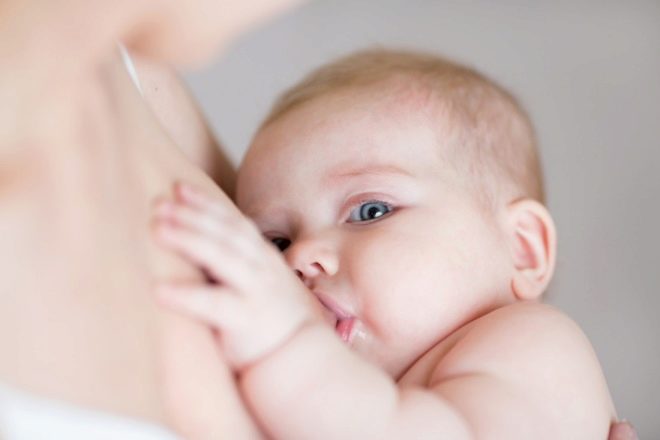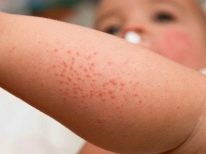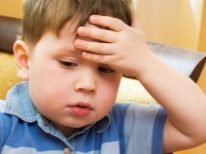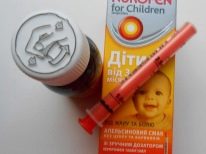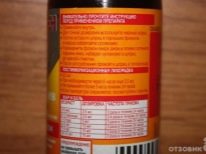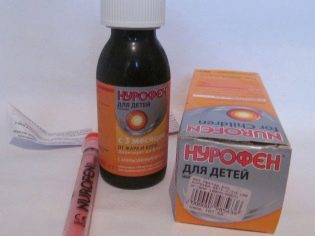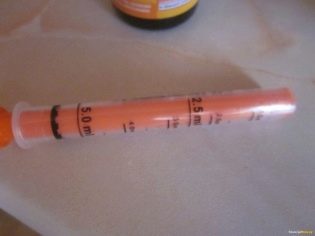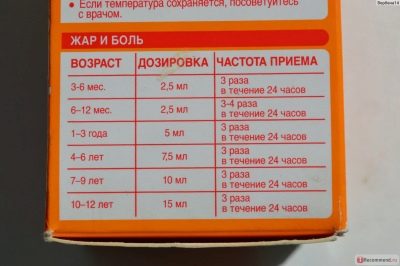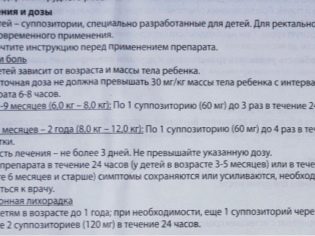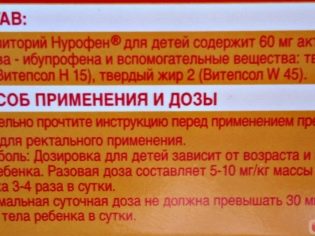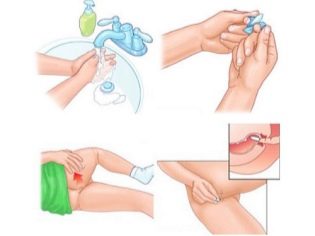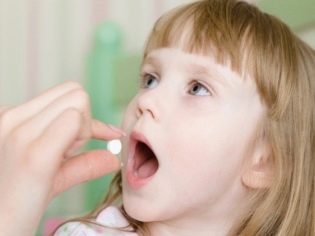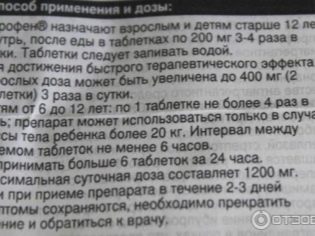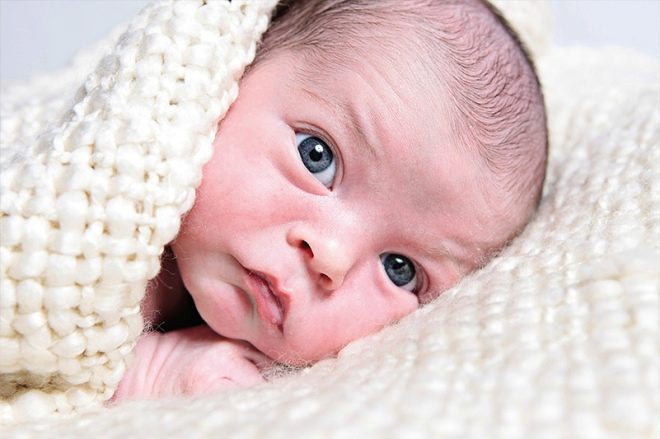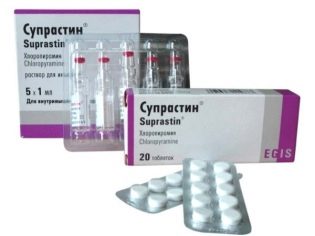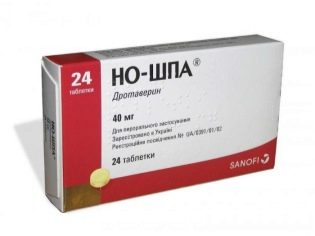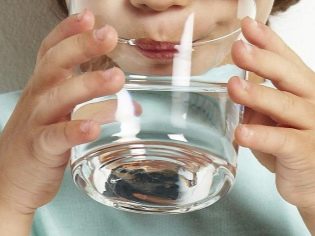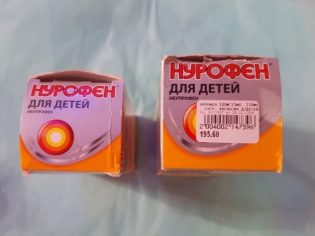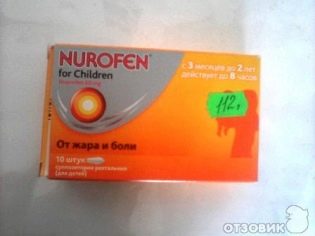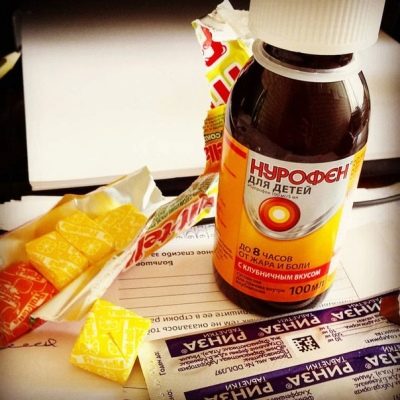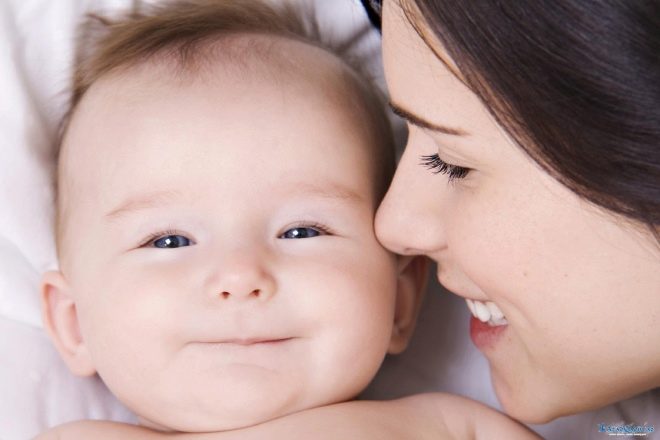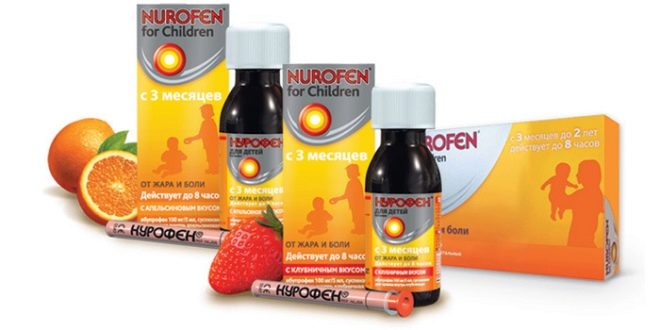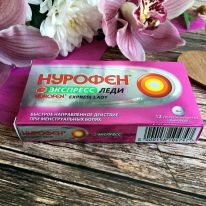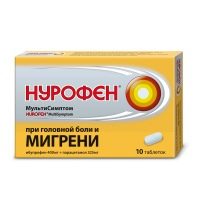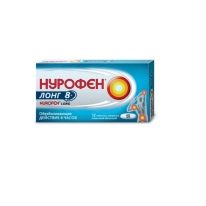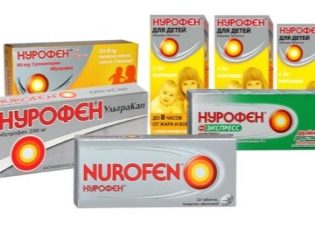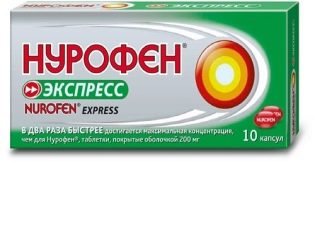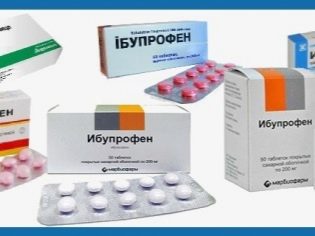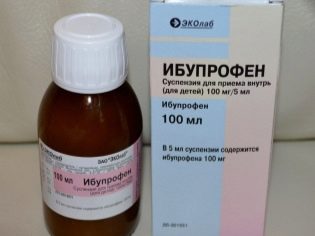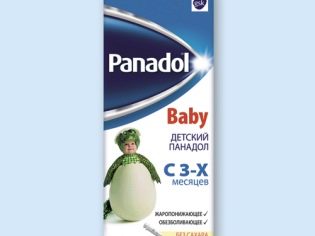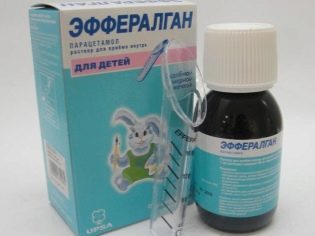Nurofen for children
Among the many drugs that help get rid of pain and reduce high body temperature, Nurofen is in high demand. This medicine is represented by several forms that can be used not only in adults, but also in childhood. When is Nurofen prescribed to children, how is it dispensed and which analogs are replaced with? Can this medication harm young patients, what is the mechanism of its action and in what situations is the treatment with such a drug prohibited?
Release form
Nurofen, which is prescribed to children, is distinguished by an orange-yellow box and is represented by these three forms:
- Rectal suppositories. They are sold in aluminum blisters of 5 pieces (a total of 10 candles in a pack). Candles removed from the package are characterized by a smooth surface, oblong shape and white color.
- Suspension. Such Nurofen is sold in plastic bottles, inside of which there are 100, 200 or 150 ml of thick white syrup liquid. It tastes sweet and smells of either strawberries or oranges. Together with the bottle in the box there is a plastic syringe dispenser, on which milliliters are marked.
- Pills. They are sold in packs of 8 pieces each, characterized by a round shape and small size. Such tablets have a sweet white shell, and on one side you can read the word Nurofen, written in black ink.
In addition to these forms, the Nurofen lineup includes several other types of tablets, gel and capsules, but these drugs are rarely prescribed for children, as they are contraindicated until the age of 12-14 due to the high dosage of ibuprofen and the increased risk of side effects.
Composition
The main ingredient of each form of Nurofen is ibuprofen.
It is contained in the medicine in this dosage:
- 60 mg in one suppository.
- 100 mg in 5 milliliters of suspension.
- 200 mg per tablet.
Auxiliary components of the suspension are glycerin, polysorbate, water, citric acid, sodium citrate and other compounds. The pleasant smell of syrup is due to the flavor, but there is no dye in this Nurofen. There is no sugar in the preparation, and the sweetness of the suspension is provided by maltitol syrup and sodium saccharinate.
Additionally, rectal suppositories include 2 types of solid fats that are needed to give the drug its shape and ease of administration into the rectum. There are no other chemicals in this version of Nurofen.
The core of the tabletted Nurofen is made of sodium lauryl sulfate, stearic acid, silicon dioxide, citrate and croscarmellose sodium. The shell of the tablets is made of talc, acacia gum, macrogol 6000, sucrose, carmellose sodium and titanium dioxide.
Operating principle
Nurofen is one of the anti-inflammatory nonsteroidal agents, therefore it is characterized by all the therapeutic effects of this group of drugs:
- Anesthetic.
- Antipyretic.
- Anti-inflammatory.
This effect is associated with the ability of the active ingredient Nurofen to influence the production of prostaglandins - mediators that are released during pain syndrome, inflammation and temperature response.
This effect is due to the ability of ibuprofen to block enzymes called cyclooxygenase 1 and cyclooxygenase 2. They "control" the synthesis of prostaglandins, therefore, when they are inhibited, the production of such mediators is inhibited, resulting in a decrease in inflammation, fever or pain response.
After ibuprofen enters the bloodstream, it combines with proteins that are in the blood plasma. In the form of such protein compounds, the substance is transferred to the tissues in which it exerts its influence.
All metabolic changes of the drug take place in the liver, so the use of Nurofen can be affected by diseases of this organ. The pathology of the kidneys also affects the treatment with this remedy, since ibuprofen is eliminated from the body of a child with urine.
Indications
The most common reason for prescribing Nurofen’s baby is an increased body temperature due to inflammation, an infectious disease, or another pathological condition.
The drug is used for fever caused by:
- ARVI;
- acute otitis media;
- flu;
- measles;
- scarlet fever;
- chicken pox;
- intestinal infection;
- pyelonephritis;
- inoculation;
- teething and so on.
Since Nurofen helps to get rid of mild or moderate pain, The medicine is also prescribed for the child:
- with sore throat;
- with inflammation of the joints;
- with sprains;
- with toothache;
- with bruises;
- with headache;
- with earache;
- with broken bones;
- with neuralgia;
- with muscle pain;
- with postoperative pain.
From what age is appointed?
Each dosage form of Nurofen has its own age range:
- Suppositories are used in children whose age ranges from 3 to 24 months.
- Suspension is appointed from three months of age and is recommended up to 12 years.
- Tablets are allowed to give children 6 years and older.
No species of Nurofen is used in newborns and infants younger than 3 months. If the baby is already 3 months old, after consulting the doctor, you can both give the drug in suspension or put candles.
A child aged 6 to 12 years can be given as a suspension, and solid form. If the patient has difficulty swallowing, they prefer syrup.
The use of suppositories in children older than 2 years is impractical because of the need for a higher single dose. For the same reason, the drug in suspension is not used in adolescents over 12 years old, since they will have to drink such Nurofen in large volumes (it is more convenient to use tablets).
Which form to choose?
Each of the variants of Nurofen has not only different age restrictions, but also other advantages.
Suppositories
Suppositories are easy to use in infants who find it hard to swallow any other food besides mother’s milk or formula. In addition, some babies do not like the sweet taste of syrup, and they protest against such a medicine, spitting it out. Candles help out when vomiting a child, which, along with fever occurs when an intestinal infection. If the baby has such a disease, then any medicine taken by mouth will further irritate the digestive tract and provoke another attack of vomiting.
The composition of the suppositories is the safest for the child’s body, since it lacks chemical additives to which the child may react with allergies. If a baby develops an allergic reaction to such a drug, then it is caused only by hypersensitivity to ibuprofen.
Antipyretic effect of rectal suppositories develops fasterthan other forms of Nurofen. Ibuprofen from the suppository is absorbed in about 15 minutes, so the temperature after the injection of the candle begins to fall in about 20-30 minutes after the drug has entered the rectum.In this case, the effect of liquid and tablet Nurofen after taking such forms begins to appear on average after 45-60 minutes.
The duration of the therapeutic effect of candles is up to 8 hours, and tablets and suspension act on average 4-6 hours.
Suspension and tablet form
Thanks to a special plastic syringe with graduations, it is very easy to measure and give the child a suspension. In addition, the dosage of this form of Nurofen is more accurate, as it allows to take into account the weight of the child, and his age.
Tablets are small in size, and thanks to the sweet shell and smooth surface they are easily ingested. This form is most convenient for schoolchildren, since it provides the dosage that children need over six years of age and eliminates the need to take a large amount of suspension.
When should I apply for fever?
It is well known that a fever with any infection acts as a protective reaction and helps the body to quickly overcome the disease. And therefore, doctors do not recommend "churning" the temperature until the child tolerates it normally.
As a rule, the condition of most children deteriorates significantly with rates above + 38.5 + 39 degrees. It is at such a high temperature that such an antipyretic drug as Nurofen should be used.
However, there are babies who need treatment at lower numbers on the thermometer. For example, if a child has had convulsions in the past with a fever or there is a high risk of their appearance (there are neurological diseases).
Some children even suffer a slight temperature rise, so they can also be given the drug earlier, not waiting for large numbers. In addition, there is no need to wait for a fever caused by vaccination or overheating, because high temperature does not perform any protective function in such situations.
Contraindications
The drug is not appointed:
- Children with hypersensitivity to ibuprofen or another component of the selected form of Nurofen.
- To babies weighing less than 5000 g (if we are talking about the use of a suspension) or 6000 g (this is a restriction for the use of suppositories). Tablet form is not given to children weighing less than 20 kg.
- Patients with active liver disease or severe insufficiency of the function of this organ.
- Children with advanced serious pathologies of the kidneys.
- Patients with ulcerative, inflammatory, or erosive damage to the walls of the stomach or intestines.
- Children who have in the past been allergic to treatment with any other anti-inflammatory drugs with non-steroid structure.
- To babies, in whose blood test an excess of potassium is detected.
- Children who have changes in coagulogram indices.
- Patients with hemophilia or hemorrhagic diathesis.
- For babies with heart failure, if the stage of decompensation has developed.
- Patients with bleeding from the gastrointestinal wall, brain tissue or other localization.
- Children with severe abdominal pain (taking Nurofen can interfere with the timely diagnosis of serious surgical diseases).
There are also separate contraindications for each form of medication. So, Nurofen candles cannot be used in children with proctitis, and the suspension is not prescribed to children who do not tolerate fructose.
It is forbidden to give the solid form to patients who have glucose-galactose malabsorption, fructose intolerance or lack of certain enzymes (isomaltase, sucrase). In addition, the Nurofen annotation includes a rather extensive list of diseases and pathological conditions requiring the increased attention of a doctor when prescribing such a antipyretic drug .
Therapy should be cautious for anemia, dehydration, hypertension, diabetes, systemic lupus erythematosus and other problems.
During lactation, the drug is allowed because it enters the breast milk in very small quantities.
Side effects
Treatment Nurofenom is the cause of allergy, which is most often represented by skin lesions (itching, erythema, dermatosis, etc.), but may be in another form (dry cough, loose stools, dizziness, shortness of breath and other symptoms). In rare cases, allergy to Nurofen proceeds in a dangerous form (angioedema, anaphylactic reaction, urticaria).
Among other side effects noted:
- The drug can adversely affect the digestive system, which is often manifested by nausea and discomfort or pain in the stomach. Occasionally, the medication provokes diarrhea, flatulence, bouts of vomiting (sometimes mixed with blood), constipation, gastric ulcer and other gastrointestinal lesions.
- Some children after taking Nurofen have dizziness or headache complaints. Only in rare cases, the drug becomes a cause of weakness, sleep disorders, tachycardia.
- If a child has asthma, the use of Nurofen can provoke an attack and cause an aggravation of such pathology.
- Sometimes the result of the use of the drug are problems with blood formation, in which the number of blood cells decreases. When they appear, the child is weak and sluggish, complains of sore throat, he may have bruises, bleeding, sores on the oral mucosa and other negative symptoms.
- In rare cases, the use of Nurofen damages the kidneys, increases blood pressure, provokes swelling, impairs liver function or causes other negative changes.
Instructions for use and dosage for children
Suspension
The bottle has a special protection against children. The drug opens as follows - by pressing the lid, it should be turned in the direction of the arrow, which is drawn on its surface. Before each use the bottle should be shaken so that the components of the suspension are distributed evenly in the water.
Tightly inserting the syringe into the neck of the bottle, you need to turn the bottle and, pulling the piston, dial the liquid to the desired mark. Next, the syringe is inserted into the patient's mouth and, slowly pressing on his piston, pour in the medicine.
After making sure that the little patient swallowed the drug, the syringe should be rinsed in water and left to dry in the place inaccessible to the baby.
It is advisable to give the suspension to children at the end of a meal or after a meal. Such use of the drug will minimize the harmful effects on the digestive system. If the infant is breastfed (HBG), the drug is given during or immediately after feeding.
A single and daily dose of liquid Nurofen for babies up to one year is determined by the age and body weight of the child:
- A child of 3-6 months who weighs 5000-7600 grams can receive medication no more than three times a day, 2.5 ml. The daily dosage for such a patient should not exceed 150 mg, which corresponds to 7.5 ml of medication.
- A baby of 6-12 months, whose body weight is 7700-9000 grams, is also given 2.5 ml of liquid Nurofen per reception, but the daily dose at this age rises to 200 mg, therefore the maximum per day is given to this child 10 ml of suspension ( drug give up to 4 times).
The frequency of receiving the suspension at the age of 1-12 years is 3 times a day, and to calculate a single / daily dose, Parameters such as weight and age are also important:
- A child older than 3 years of age and weighing from 10 to 16 kg gives 5 ml of syrup per reception, that is, a day - a maximum of 15 ml.
- A patient of 4-6 years old, who weighs 17-20 kg, shows up to 22.5 ml of medication per day, which corresponds to a single dosage of 7.5 ml.
- A child of 7–9 years old with a body weight of 21–30 kg gives 10 ml of suspension at a time, and up to 30 ml per day.
- A patient of 10–12 years old who weighs 31–40 kg should be given 15 ml of Nurofen at a time, that is, the daily dose is 45 ml.
Candles
This form of Nurofen is used rectally, and to determine the dosage, as in the treatment with syrup, it is important to know the baby’s age and its body weight in kilograms.Cutting one candle from the blister and removing aluminum packaging from the medicine, you need to lay the child on its side.
Carefully inserting the suppository into the anus, it should be pushed with a finger to a depth of approximately half of the second phalanx.
A single dose for a child of 3-24 months is 1 candle, that is, 60 mg of ibuprofen. At the same time, the maximum permissible amount of the active substance for a child weighing 6-8 kg (this is approximately from 3 to 9 months) is 180 mg, which means that the drug can be applied during the day a maximum of three times.
If the patient's body weight is from 8 to 12 kg (this weight is typical for children 9-24 months), it is allowed to use four times, since the maximum allowable daily amount of ibuprofen for such babies is 240 mg.
Candles are inserted with a time interval of 6-8 hours, preferably after bowel emptying. If the medication provokes defecation within 15 minutes of the drug administration, it is permissible to reintroduce the candle, but it is better to wait some time to make sure that the medication did not have time to be absorbed.
If the temperature does not “fall down” 20-30 minutes after using the candle, you can safely put another suppository.
Pills
A single dose of medicine for children over 6 years old is 1 tablet. If the patient is already 12 years old, the dosage can be increased to two tablets per reception.
The maximum amount of ibuprofen per day for children from 6 to 18 years is 800 mg. This means that tablets of 200 mg can be taken up to 4 times a day (the interval should not be less than six hours), and if the dose is 2 tablets at once, then only a two-fold dose is acceptable.
Nurofen in this form should be swallowed and washed down with water, and so that the ingredients of the drug irritate the stomach less, it is recommended to be taken after meals or during any meal.
Use after vaccination
When using Nurofen as an antipyretic agent in response to a temperature response to vaccination you need to take into account such moments:
- The drug is often used once as a dose of 1 suppository or 2.5 ml of suspension.
- If the child is older than a year, after 6-8 hours after the first dose, while maintaining fever, you can give another 2.5 ml of syrup or insert another candle.
- If the temperature is still high after a single use of the drug in a child under one year old or twice in a patient older than one year, you cannot give Nurofen again. In such a situation, you should call a doctor.
Duration of treatment
Using Nurofen in children, it should be remembered that it is primarily a symptomatic remedy, therefore, its use has its time limits:
- If medication is prescribed at high temperature, it should not be given to babies longer than three days. A patient whose fever persists on the third day of using Nurofen also needs a doctor’s consultation. If the child is only 3-5 months old, then you need to go to the doctor even earlier - if there is no improvement in the first 24 hours after the baby started to give syrup or introduce suppositories.
- If the drug was prescribed to eliminate or reduce pain, the duration of use, according to the recommendations of the manufacturer and doctors, should not exceed five days. If on the fifth day of Nurofen's application the painful sensations persist or intensify, the question of continuing therapy should be decided together with the pediatrician, who is observing the little patient.
What if the medicine does not work?
In some children, Nurofen's intake does not lead to the expected drop in temperature to normal numbers, and after a few hours it begins to grow again. However, the manufacturer advises to give the drug again not earlier than after 6 hours.
In many cases, the pediatrician will recommend alternating Nurofen with one of the paracetamol preparations.
Sometimes they resort to the use of a lytic mixture, including two or three drugs at once - antipyretic, antihistamine (most often Suprastin) and antispasmodic (often used No-shpa). However, it is impossible to give such a mixture to children in pills or to inject without a pediatrician.
If it is required to take the antipyretic agent again, the consultation of the doctor is desirable.
Overdose
Taking a very large dose of Nurofen provokes:
- Nausea
- Stomach ache.
- Noise in ears.
- Diarrhea
- Headache.
- Drowsiness.
- Vomiting.
- Respiratory depression
- Cramps and other negative symptoms.
If an overdose was detected almost immediately (up to an hour after taking a very large dose), resort to gastric lavage and give the child a sorbent.
If it is detected later, it is recommended to drink plenty of fluids so that the drug is quickly eliminated from the body with urine, and if the baby’s condition worsens, you should immediately seek medical help.
Interaction with other drugs
Nurofen should not be given to children along with many other medications, including:
- Paracetamol;
- Cyclosporine;
- Antacids;
- Nimesulide;
- Diuretics;
- Caffeine;
- Cardiac glycosides;
- Thrombolytics;
- ACE inhibitors;
- Ketorol;
- Tacrolimus;
- Methotrexate;
- Acetylsalicylic acid;
- Zidovudine;
- Antibacterial agents of the quinolone group.
When combined with most of these funds, the risk of side effects of ibuprofen increases or the effect of treatment decreases. And therefore, Nurofen should be used in children who already receive any medication, only after medical consultation.
Terms of sale
All types of Nurofen without any problems are purchased in pharmacies, as they are non-prescription drugs. The average price of 10 candles is 90-110 rubles.
A bottle of 100 ml of the suspension costs about 130 rubles, for a 150 ml bottle it is necessary to pay 180-190 rubles, and 200 ml of medicine costs about 250 rubles. Packaging Nurofen tablets for children costs about 100-110 rubles.
Storage features
To Nurofen not lost its healing properties, it must be stored in a dry place away from direct sunlight at room temperature.
To store the candles low temperature is not required, so they can be kept not in the refrigerator, but in any other place where the temperature does not exceed +25 degrees. The shelf life of suppositories is 2 years. If it has expired or the aluminum packaging is damaged, the medicine must be discarded.
Suspension can be stored up to 3 years from the date of its manufacture (it should be specified on the box), and the shelf life of such Nurofen after opening the bottle does not change. The shelf life of tablets is also 3 years from the date of manufacture of the medicine.
It is also important to hide the medicine from small children (especially the suspension, because due to the sweet taste, the risk of taking this medicine in a high dose is increased).
Reviews
Most of the reviews on the treatment of children Nurofen - positive. Moms and doctors praise such a tool for its effectiveness and variety of forms, allowing you to choose the best option for a particular child. Nursing babies are more likely to choose candles, noting that their shape is comfortable, the composition is harmless, and the effect of use is very fast and long lasting.
Suspension is also called easy to use, and most babies like its taste. The advantage of this form is also considered to be the absence of sugar in the medicine.
As for the tablets, then, as the parents note, the medicine in the orange box is small in size and has a smooth sweet shell, therefore, children with over six years of age often have no difficulty in swallowing it.
Portability Nurofena in candles, according to parents, good, and some babies have a negative reaction to the suspension or tablets (often from the digestive tract or in the form of allergies).
Many parents assess the price of medication as acceptable, but opinions are often found that the cost of the drug is too high, which is why many mothers choose cheaper analogues, but with the same effect.
Is it possible to replace the children's tablets Nurofen adult tablets or capsules?
In the pharmacy you can find not only orange, but also silver boxes of Nurofen tablets, containing 200 mg of the active substance in one tablet. In one such pack can be from 6 to 96 tablets, placed in blisters of 6-12 pieces. This medication is completely identical to tablets that are in orange packaging labeled "6 years old."
They have the same form, the same inscription on the tablet, exactly the same composition and completely identical readings. These tablets can be used to replace the solid form of Nurofen for children, as they are also allowed to be given to patients older than six years in the same dosages as children's tablets.
However, in the line of tablets Nurofen there are other drugs that differ in dosage and composition:
- Forte is a medicine with a double dose (each such tablet contains 400 mg of ibuprofen).
- Express Neo is a drug that has a faster effect (due to the special ibuprofen compound that is absorbed faster).
- Multisymptom and Long are the types of Nurofen, which also include paracetamol.
- Plus - another two-component version of the drug, in which ibuprofen is combined with codeine for a stronger analgesic effect.
- Express Lady is a fast acting drug containing 400 mg of ibuprofen per tablet.
All of these tablets are contraindicated for children under 12 years old and must be prescribed by a doctor. As for Nurofen in capsules, it is represented by such species:
- Express - 200 mg in one capsule.
- Express Forte and UltraCap Forte - 400 mg in each capsule.
They are also not used in pediatrics until the age of 12, and at the age of 12-18 years old, they use no more than 800 mg ibuprofen per day.
Gel Nurofen Express
The drug in this form is used for painful sensations in the back, muscles and joints. It looks like a uniform, transparent, colorless substance with a peculiar smell. The gel is produced in tubes of 30-200 grams, and the concentration of ibuprofen in it is 5g / 100g.
The gel is used to treat the site of ligament damage, joint inflammation or muscle tension. This Nurofen is especially in demand for injuries received during sports activities, as well as for neuralgia.
It acts mainly locally, so side effects and overdose are not found. However, the gel is not used in children under 14 years of age.
If the drug is prescribed to a teenager, it is applied with a strip of 4-10 cm and rubbed into the skin, after which the hands are thoroughly washed. Lubricate damaged or infected skin is contraindicated.
Repeated application is allowed at intervals of not less than 4 hours, and you can only use such Nurofen per day up to four times. The duration of the gel is up to 2 weeks.
Analogs
The most popular generic of Nurofen is Ibuprofen, as the basis of this medicine is the same active compound. Ibuprofen is also produced in suppositories, suspensions and solid form, prescribed for the same problems (fever, pain) and not used for the same diseases that are contraindicated to the use of Nurofen.
He is often chosen as a replacement for Nurofen, since Ibuprofen has the same effect, and the price is slightly lower.
Nurofen in suppositories can be replaced not only Ibuprofen Candles, but also paracetamol-based suppositories - Children's Panadol (appointed from 6 months) Cefecone D (allowed from 1 month), Efferalgan (used from 3 months). In rare cases, resort to the use of suppositories. Analgin, Voltaren or other means.
Liquid Nurofen is usually replaced by others. syrups and suspensions with a similar effect. It may be drugs ibuprofen (Maxicold for children, Ibuprofen-Akrihin, Ibufen), and products that contain paracetamol (Calpol, Efferalgan, Children's Panadol, Paracetamol).
Instead of Nurofen in tablets, you can use Faspik, Mig 200, Deblok, Ibuprofen-Hemofarm, Perfalgan, Paracetamol, Panadol, Nimesil, Nise, Ketanov, Analgin and other drugs that have the same therapeutic effect. But before using any of these tools in children, it is advisable to consult a doctor, because many of them have other active substances and various contraindications.
More information about antipyretics see the transfer of Dr. Komarovsky.
